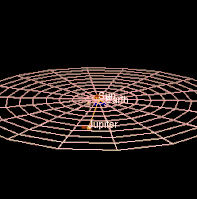In
this reaction four hydrogen atoms combine to form one helium atom.
The mass of one helium atom is a little bit less than that of these
four hydrogen atoms. The difference in the mass is called as mass
defect. This mass defect appears in the form of binding energy which
binds the nucleons (protons and neutrons) in the nucleus. According
to Einstein’s equation “E =mc2”
a tremendous amount of energy is released.
The
largest stars contain matter which is about 120 times higher than the
matter in our sun. They rapidly generate large amounts of energy by
consuming the matter inside them. This energy is useful to prevent
the collapse of the star due to gravitation. The temperature of a
very bright star would be about 70,000℉.
They will be radiating a large amount of heat and light and will
exist up to lakhs of years only.
Our
sun is at a temperature of about 10,000℉
and will be radiating up to thousands of crores of years. Very small
stars which have only 8% matter of the sun at 3-4℉
will exist of lakhs of crores of years.
After
hydrogen is exhausted in a star its end approaches. The star will
expand rapidly such that its diameter will be hundreds of crores of
miles. This stage is called as “red giant”. So, the temperature
of the star will be reduced. At this stage it might radiate energy
due to some nuclear reactions occurring inside it. Eventually it will
run out of fuel. The outer layers expand, cool and will shine less
brightly. The core becomes a “white dwarf” that gradually cool
down and dims. When it finally stops shining altogether, the dead
star will become a black dwarf.
Massive stars have a mass at least three times that of
the sun. these stars after passing through the stage of being a red
giant explode and the outer layers are blown away by a shock wave.
These supernovae shine brighter than an entire galaxy for a short
time. The core may or may not survive the explosion. If the core
survives and its mass is between about one and a half solar masses,
it contracts to become a tiny, dense neutron star. If the core is
considerably greater than three solar masses, it contracts to become
a black hole


